
OUR VERDICT
With the HomePod, we’re really reviewing two things at once: a premium speaker and a smart home hub. In the former category, the HomePod is excellent, with amazing sound and incredibly intuitive set-up. But in the latter Siri is only middling in its implementation, and the fact that you’re not able to break out of the Apple ecosystem for many key functions also rankles.
FOR
- Amazing sound quality
- Siri voice accuracy is high
- Attractive, understated design
AGAINST
- Siri is limited
- No Bluetooth streaming
- Apple Music subscription needed for a worthwhile experience
Apple’s devices have evolved hugely over the last 15 years or so, changing the brand from the rebooted upstart that gave us the iPod to the consumer tech powerhouse of today.
The HomePod takes the name of that iconic portable device, but a decade and a half on we’re faced with the same question posed by previous Apple gadgets: how much of a premium should you pay for owning a device that fits seamlessly into the Apple ecosystem?
Let’s not forget that the HomePod is a late entry to the smart speaker game, but that’s standard operating procedure for the Cupertino-based brand: let the rest of the industry stride ahead with a new form factor, identify the issues and then offer something that ‘just works’… and generally for a higher price than the competition.
That’s what’s happened with the HomePod, although not in quite the same way as before. There’s no denying that the sound quality of Apple’s speaker is top-notch, but in a marketplace where Amazon has such an entrenched smart speaker/voice assistant ecosystem and Google isn’t far behind, can a great-sounding-but-imperfect device be worth buying? Or should you wait for the Apple HomePod Mini?
Apple HomePod price and release date
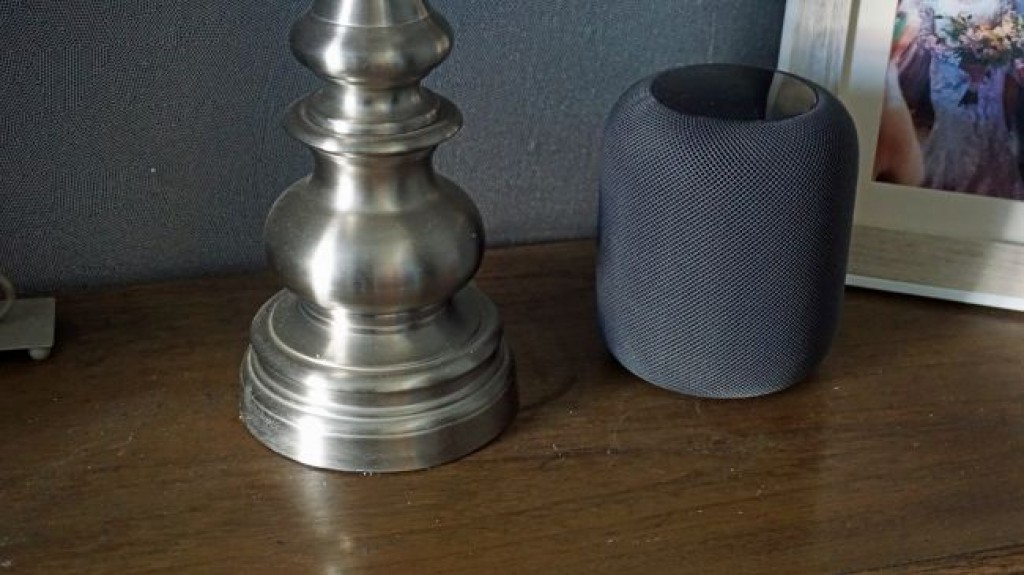
As intimated, the HomePod price isn’t a cheap speaker – the price is a weighty $349 / £319 / AU$499, and the speaker began shipping on February 9 in selected territories.
That makes it one of the most expensive smart speakers on the market – and certainly the most expensive mainstream option – but Apple is hoping to justify that price by embedding Siri inside and offering premium-quality audio.
Set-up
- By far the easiest smart speaker to set up
- Capable of reading own surroundings

The Apple HomePod is so, well, Apple in the way you’ll use it. As with the AirPods, simply hold your phone near the unit and your handset will send over your Apple ID and Apple Music preferences, and fill in all the long-winded Wi-Fi passwords that you’re proud you remember but thankfully don’t have to type in.
The set-up process was only delayed for us by the fact that we needed to upgrade to a newer version of iOS on our iPhone, which is a prerequisite for making the speaker work.
That highlights one key thing about the HomePod: you’ll need to have an iPhone or iPad to set it up in the first place.
It’s hard to see why you’d buy this speaker without owning one of those already, but it trims the target audience down right from the outset.
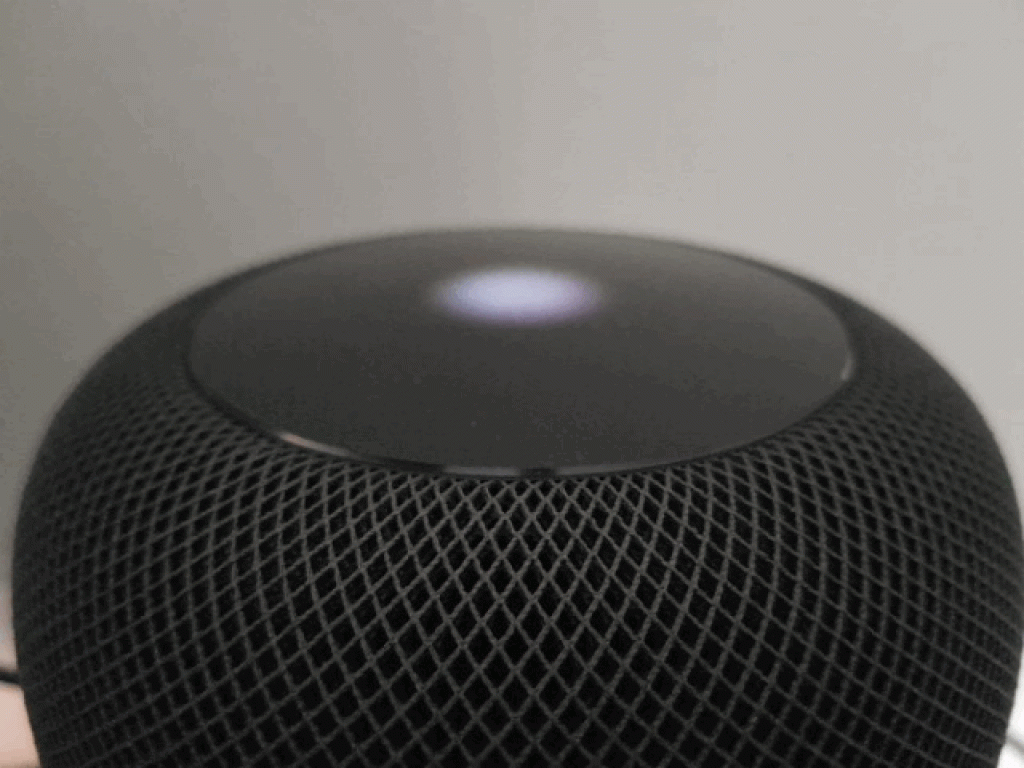
However, the set-up process does highlight one of the nice features of the HomePod: the glowing light on the top (which turns into the multi-colored Siri logo when you’re issuing commands to it later on).
The whole process is so swift though – compare it to the long-long-long-winded set-up process for the Amazon Echo or Sonos One – and you’ll be so glad that you don’t have to spend a minute wafting your iPhone around the room to calibrate the sound levels.
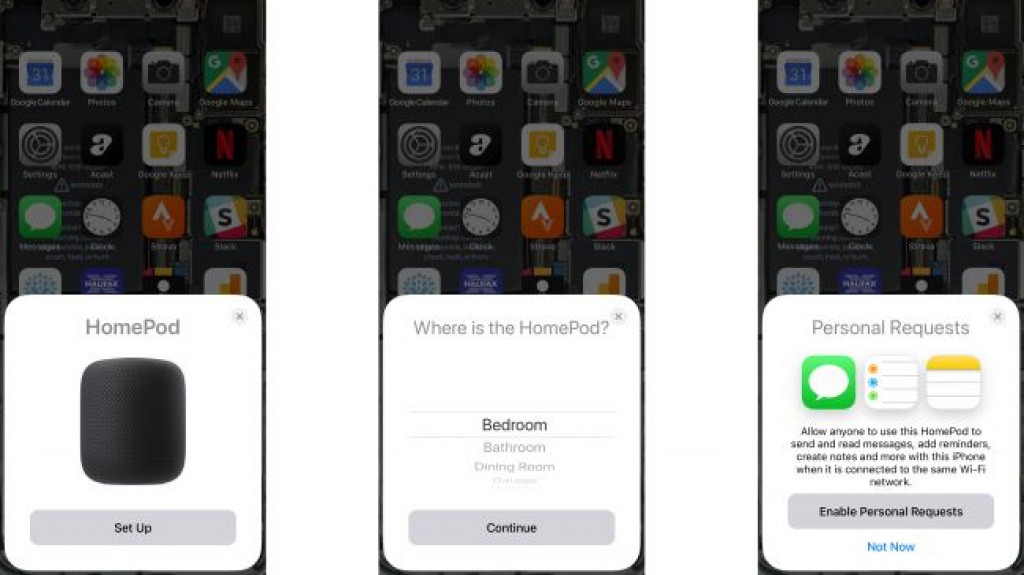
Add to that further such conveniences in day-to-day use – if you need to use a new Wi-Fi network that’s already set up on your phone, you just literally hold the phone nearby and it’s done – and you can see how Apple has smashed the competition when it comes to ease of use, one of its real hallmarks.
The HomePod will actually just work out where it is within the room simply by playing some music – it’ll assess its physical surroundings by hearing how the sound it emits bounces around, and if there’s a wall behind it will send certain sections of what you’re listening to that way, while the main vocals or instruments will fire forwards.
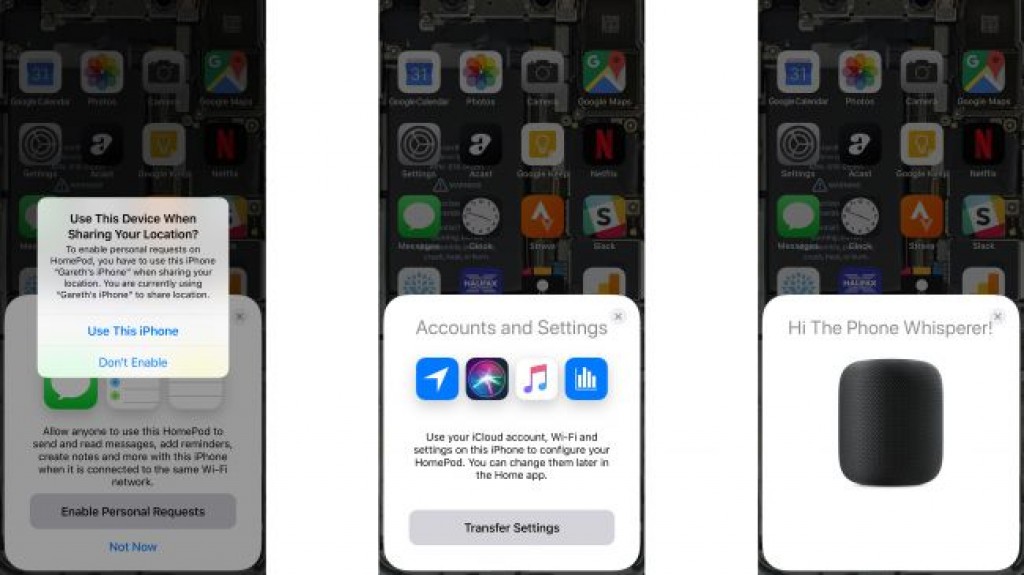
If it’s not adjacent to a wall then the HomePod will chuck the sound out in a 360-degree space, although in most cases we’d imagine people would use the speaker up against a wall.
After that’s all set up, you can leave the house with your iPhone and your family or housemates will still be able to use the speaker, although you can turn off ‘personal requests’ based on your information if you don’t want other people meddling with your business.
(Thankfully you can also stop requests to the speaker messing with your music listening history – if you’re trying to build decent automated playlists on Apple Music, your housemates playing Justin Bieber and Moana on repeat won’t ruin everything.)
Design
- Understated design
- Much heavier than expected
If you’re thinking of picking up the HomePod you may want to go with both hands to start with. That’s because this speaker is incredibly dense, packing 2.5kg of weight into its 172mm (6.8-inch) high frame.
It feels a good deal heavier than it looks, and that’s because there are so many speakers in there. We’re talking a woofer and seven tweeters, each with its own amplifier, and six microphones spread around to help pick up your voice when you’re hailing Siri.
And once its placement is locked in, you’ll need to answer one more question: how are you going to run the power lead that comes out the back? It’s the only wire on this device, and the only thing that resembles a port too. There’s no other physical connectivity on offer, which sadly means no aux-in port for connecting up a record player or other device.

All you’ve got is a squat little speaker covered in an ‘acoustic mesh’ that’s designed to protect the device while letting out as much sound as possible. It looks as unremarkable as you’d expect – there are no decorative flourishes here – and the only break in the mesh is on the top, where a round, reflective disc sits.
This is, as we’ve mentioned, where the glowing light pulses, signifying when Siri is listening and processing commands, and it’s also where you’ll find the plus and minus icons for adjusting the volume.
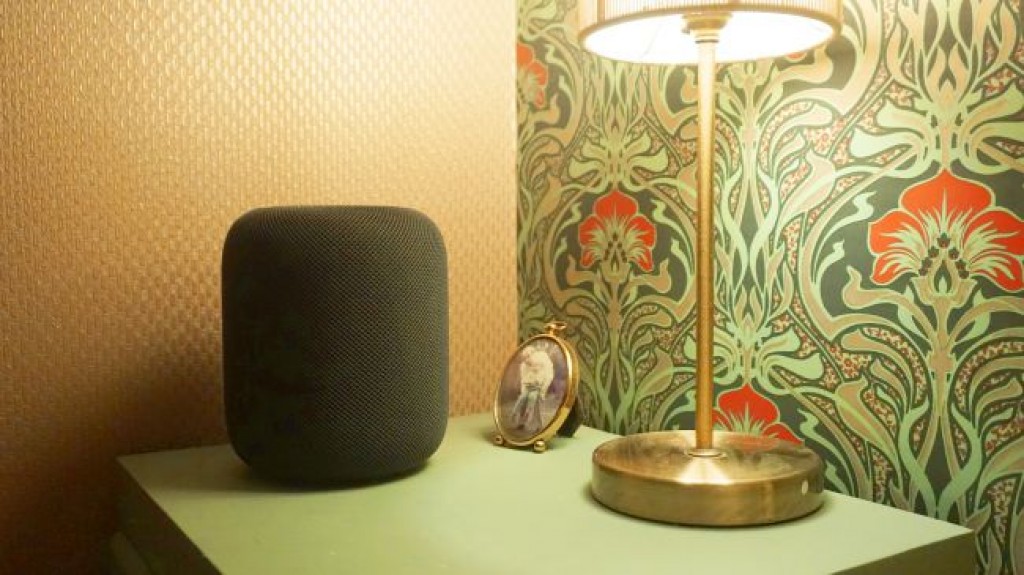
It’s a shame there’s no haptic feedback from the buttons, but given that most of the time you’re going to be controlling the HomePod with your voice it’s not a big deal.
The HomePod isn’t the most aesthetically pleasing speaker out there, but it’s attractive in its simplicity. Some might think that, for the price, it should be more striking, but the speaker is certainly well-made.
And be warned – the Apple HomePod can leave a white ring underneath if you leave it on certain surfaces (mostly more expensive, porous wood). Apple has acknowledged this and says it should wipe off, or disappear after a few days, but other claims state that it can leave a more permanent ring. Either way, think about where you place the speaker, as the vibration causes a reaction between the silicon base to the wood thanks to the deeper bass.
We had our speaker on a wooden surface in our testing, but it was a thinner (well, cheaper) wood, and found no example of the staining… but it seems that more porous, expensive veneers are those in danger.
In terms of processing, the HomePod is equipped with Apple’s A8 chip, created to be used in the iPhone 6 from 2015. That may sound a little old, but given that it was designed to power a whole smartphone, it’s actually quite a lot of power for ‘only’ a speaker, even one that’s sending and receiving commands to and from the cloud on a regular basis.
Audio performance
- Sublime audio performance
- No Bluetooth streaming or aux input
The audio quality of the Apple HomePod is, to put it simply, premium. It fills a room easily, with clear separation between all elements of music tracks.
It’s certainly at its best when placed against a wall, pulling apart the sounds well, with elements such as voices coming through with incredible breadth.
We’re probably all used to hearing music of various quality throughout our day, from poor-quality headphones to whatever speakers our TV has, so using the HomePod will expose a lot of people who aren’t audiophiles to new subtleties in music which they may not have heard before.

The bass, in particular, is strong, but like most sounds emanating from the speaker the audio is stable, with sharp notes clipping very well. Listening to electronica, in particular, offered a lot of clarity, while bass guitar sounds brought a slight reverberation to the sound – those with an untrained ear in particular will be blown away.
But it’s the fusion of all this that’s impressive – being able to hear thudding bass (a teeny bit too thudding at times, it has to be said) while at the same time being treated to crystal-clear vocals on top is a lovely experience.
Sometimes you’ll feel that things can get a little mixed together – bass guitar can be a touch muddy, or something like a violin can be easily overpowered – but compared to a cheap, low-end speaker the quality is just miles and miles ahead.
The HomePod is loud too, with Siri asking if you definitely want to do that when you ask the speaker to play at full volume. And if there are any sound effects on a track, be it water splashing, rain or a faux-vinyl sound, the crispness again is amazing.
In fact, the audio quality is so good that the biggest criticism we can level at the audio capabilities of the speaker is how you interact with it. Saying ‘Hey Siri’ over and over to achieve anything irks, and if you’re in a room with multiple people talking you’ll need others to shush otherwise their words are easily picked up, leading to random songs being played.
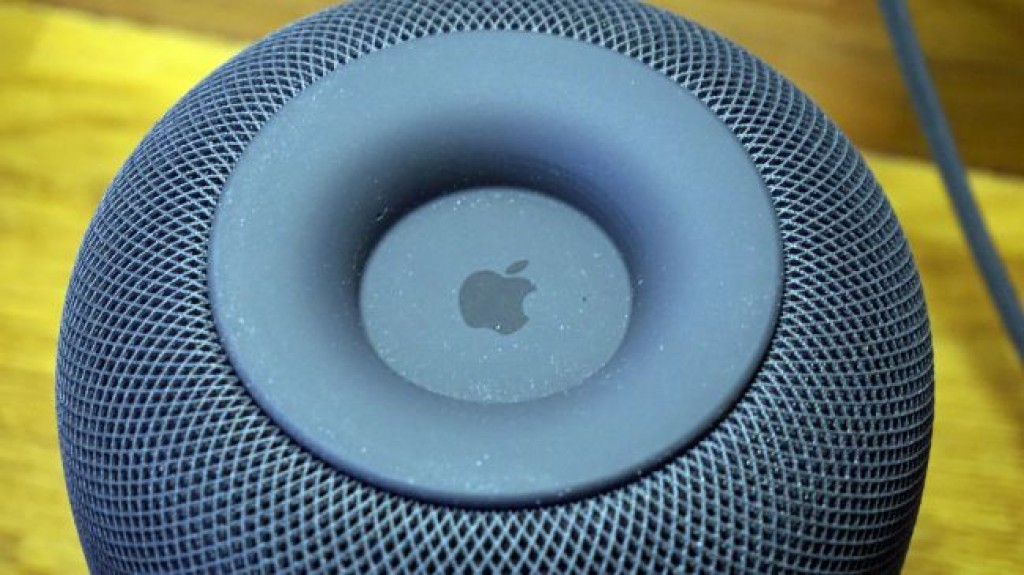
It would be nice to somehow have your intentions registered without the need for a key phrase.
Comparing the HomePod to the new Amazon Echo and the Sonos One, though, it bests both of them easily. Leaving aside the simple set-up, which is a godsend, the sound from Apple’s speaker is the most expansive and clear… it just feels like there’s more information flooding into your ears.
The Amazon Echo is obviously the lowest-quality of the three in terms of sound quality, but it’s not terrible. Listen to it in isolation and you’ll like how it sounds, especially for the price. But the HomePod just destroys it with the level of audio on offer, making music sound, well, ‘proper’.
The Sonos One is understandably much closer to the HomePod when it comes to audio performance, but it’s not quite as good – the only way we can describe it is as being ‘narrower’ in its sound, with the volume and breadth of the audio not matching Apple’s efforts.
That’s not to say the Sonos One’s sound quality isn’t hugely clear and evocative – it thoroughly is – but there’s just more power and depth from the HomePod.
But now we get onto how you actually listen to things on the HomePod, and therein lies the rub. You need a subscription to Apple Music unless you just want to stream stuff from your iPhone – and even that can only be done using AirPlay.
We say ‘only’ because you can’t stream over Bluetooth to the HomePod. That’s not a massive issue if you’ll only ever want to play audio from an Apple product, but if you’ve got something else that can be used to stream Bluetooth music you’re out of luck.
Similarly, with no aux input you won’t be able to use the premium sound of the HomePod to play your CDs, or your vinyl collection if you’ve jumped on that particular bandwagon.
We can see the argument for not offering Bluetooth streaming – despite there being a Bluetooth connection on board to enable the HomePod to talk to other smart home devices – but not having an aux input is a missed opportunity.
So, given the above, how are you supposed to get the most out of your HomePod? With the aforementioned Apple Music – meaning you’re essentially going to need to pay $10 / £10 a month to keep using your new speaker.
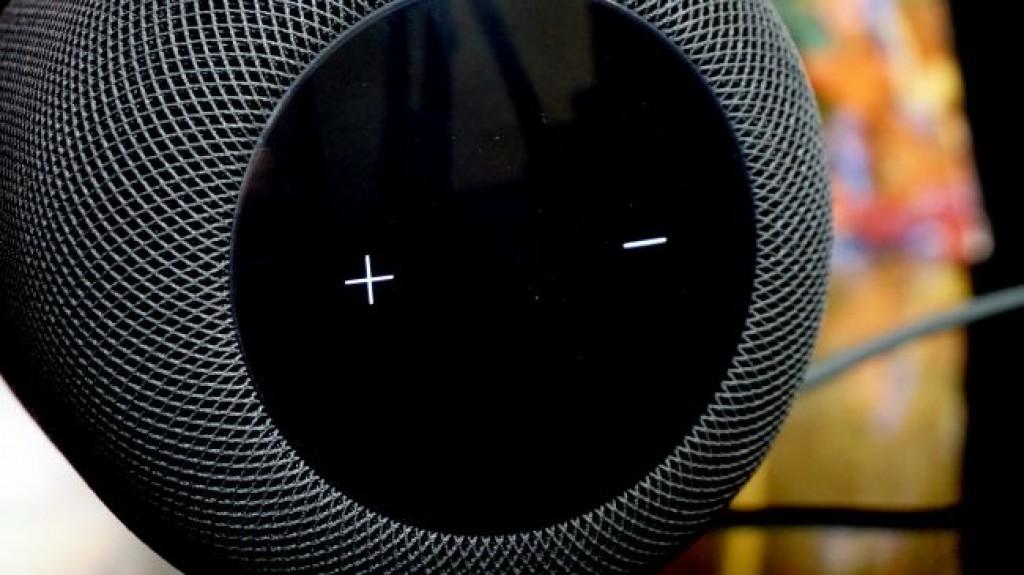
If you’re already paying that, no problem – but if you’re currently a Spotify user you won’t be able to use that service without streaming it over your phone, which isn’t ideal – you can still control the music using your voice in this mode, but it’s a lot slower to respond.
The fact that you’re pretty much locked to Apple Music makes it all the more curious that Apple doesn’t have a lossless format, like Tidal, given that the HomePod is tailored for such high-end sound.
Perhaps that’s coming in the future. Or perhaps Apple thinks the sound is good enough with what’s there – and as we’ve said, it is great.
But the fact that you can only use Apple Music rankles, further highlighting how you need to be deeply embedded in the Apple ecosystem to get proper use out of the HomePod.
Speaking of the future, thanks to AirPlay 2, you can now link two HomePods together to get stereo sound, or add in speakers from different brands to spread your sound to them too. The list of AirPlay 2-compatible speakers currently includes the Sonos Playbase, Sonos Beam, Sonos One and Sonos Play:5 speakers, plus speakers from Bang & Olufsen, Libratone and Naim are plugged for AirPlay 2 as well.
We tried it with the Apple TV, and while the sound was brilliant we had to dive into the settings every time to tell the TV to play the sound through the speaker. Having two HomePods proudly sitting either side of the screen and automatically playing the audio from Netflix or whatever would be great.
We were looking forward to having two HomePod speakers that we could AirPlay music to – while you can’t Bluetooth stream audio to them, you can send music from an iPhone or iPod – but it was often disastrous.
When trying to play Spotify to both, there was a noticeable lag between the two, that only constantly starting and disabling the sound could eventually fix. It certainly isn’t the premium experience we’d expect from Apple.
Also, there’s no easy way to link the volume of both together. Yes, you can control the sound of each from the iPhone, but one would assume that you could link them both easily to the same level.
Overall, it’s not the premium dual-speaker experience we expected from Apple when stepping outside of just requesting music with your voice.

Siri and the smart home
- Siri very capable at hearing your words
- Needs to be able to do more
The Apple HomePod isn’t just a speaker, despite the company telling the world that this is a music-first proposition.
The feature that’s going to see you using this thing regularly is the ‘Hey Siri’ functionality that’s baked in, meaning that you’re able to speak to the HomePod to ask all manner of things.
In fact, this speaker is designed to not really be touched, with interactions ideally done via voice.
With that in mind, it’s a good thing that the voice recognition accuracy is incredible. Even if you’re lying with your back turned to the speaker, or in another room, saying (not shouting) ‘Hey Siri, turn up the volume’ will be recognized nearly every time.
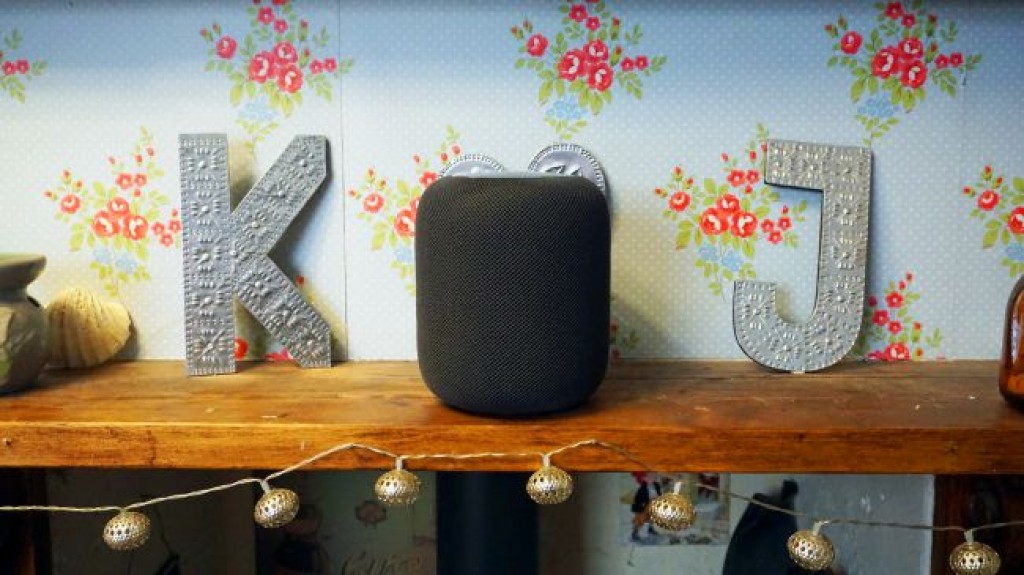
Even through loud music your voice can be picked up, which seems impossible and shows that those six microphones are really doing their job.
As we’ve said, though, you’ll soon tire of having to say ‘Hey Siri’ over and over again, especially when skipping through tracks. Also, if you’ve got any other Apple device in the room that will light up in anticipation too, before realizing that it’s not wanted and slinking away.
That’s not a major issue, but it’s not going to help your iPhone battery, for instance.
Siri does speak very normally though, answering your commands and questions naturally. In fact, the way you can speak to the HomePod is awesome, with natural language recognized in every situation.
For instance, when the alarm is going you can say ‘Hey Siri, thanks!’ and she / he will respond with ‘I live to serve!’, which is a nice touch.
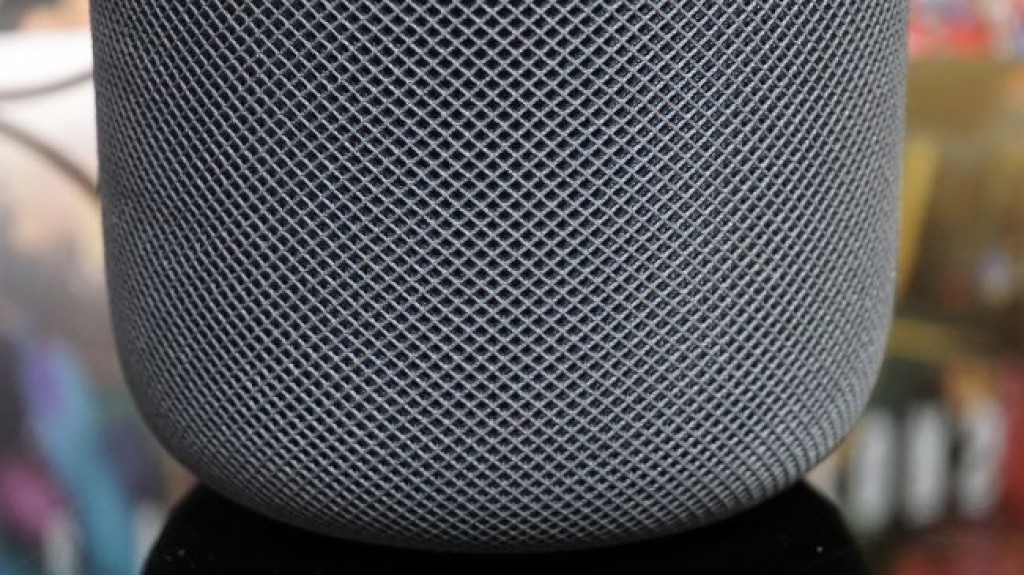
For day-to-day interactions, Siri is great and rather intuitive. The natural language means there’s very little barrier to getting comfortable with speaking to your HomePod, so you can say ‘Hey Siri, shuffle my Just Songs playlist’ and it’ll know what you mean.
You can add tracks, skip forward or back or even rewind a few seconds just by asking it, and that will work flawlessly.
This doesn’t just extend to music either – you can say ‘Hey Siri, play the latest episode of the Football Ramble podcast’ and Siri will search the catalogue and oblige.
We did note that when using two speakers, controlling the volume of them both was very hit-and-miss. Sometimes the volume would alter on one, or both, or neither it seemed. This was most annoying when you play music late at night and the volume was a bit loud, and saying ‘Hey Siri, volume 10% everywhere didn’t seem to have the right effect.
One of the things Apple is pushing hard is the ability of the HomePod to help you discover the music you like, for it to get smarter over time.
Asking it to do that did yield new tunes that we enjoyed, although they were songs from artists we already had in our library.
There are still some gremlins in the discovery engine that we imagine will take a few weeks of music playback to iron out. Things like asking Siri to ‘play some wake up music’ in the morning and it spitting out country sounds – it’s energetic, yes, but nowhere in our thousands-strong music catalogue is there any such music… even telling Siri we didn’t like it didn’t change the genre.
Another thing we noted in our time testing the speaker: we wish we could change ‘Hey Siri’ to something else. We actually called her ‘Sizzle’ one day in a low, low moment.

HomeKit
Siri’s capability isn’t just to respond to your words – it’s also the conduit to controlling your smart home.
That begins within the speaker, and as an alarm clock the HomePod also needs some work, as it’s only got a single tone to rouse you with, and you can’t ask Siri to play the news instead. You can ask it to play the news when you wake, and after a while it will save your preferred station too.
There are some kinks here – when we first asked for sports news it started playing just that, but from the day before. Sure, these are mostly just little kinks in the system, but for the money we’d expect the experience to be flawless from the off.
And that’s kind of the way this speaker feels – still in beta mode, even months after launch. Without the ability to connect to other services, you wonder if the Apple stable is enough. Yes, you can create to-do lists, play music, set a timer etc… but, as another example, you can only set one timer, and a lot of people like to have multiple options when cooking.
Apple’s smart home ecosytem is called HomeKit (if you’ve not heard of it yet) and controlled primarily through the Home app on your iPhone, iPad or Apple Watch generally.
Setting up something like a smart plug or smart light is as simple as scanning the code on the device from your phone or tablet and having it added into the mix – once that’s done, you’re able to control it with your voice.
It’s brilliant to be able to walk through the door, say ‘Hey Siri, I’m home!’ and all the lights you’ve set up blink up because your lamps have smart plugs.
Or saying ‘Hey Siri, goodnight!’ and having the lights fade out and the TV turn off – and the curtains shut if you’ve inexplicably already decided smart blinds are a good idea.
Less nice is the fact that you can’t turn the voice off, nor change the volume. So walking in late at night and saying ‘Hey Siri, turn on the lights’ will still result in the voice blaring back at the same volume as in daytime: ‘Okay, that’s done!’
Or, while it’s nice to have bedtime automated, Siri still enthusiastically, and loudly, responds when you say ‘Goodnight!’, which isn’t ideal when half the house is asleep.
There’s also still a real lag on some connections with items of HomeKit, with things like lamps showing as ‘updating’ on the iPhone app and uncommunicative for the HomePod.
Or, if you’ve got an automation set, often it’ll take a while to connect to all the devices, with a ‘Hmmmmm, not all your devices are responding’ message popping up before all the lights going out a few seconds later. Nothing major, but more friction than expected.
Also, if there was a HomePod App Store for adding functionality, in the same way Alexa has skills, this would be a brilliant speaker.
The HomePod operates so much slicker than the Alexa speakers we’ve tried, and with the minimum of fuss, but people might want other news sources, other connections, and other streaming services to play over their expensive speaker.
But then again, such limitations have been a hallmark of Apple’s walled-garden approach, and it has – time and again – proved people will buy such things, further embedding themselves into its ecosystem.
Final verdict
Once again, we come to the familiar question with Apple: is it worth spending your money on this product, or are you better off doing so on one that’s cheaper and does a lot of the same things, albeit without, perhaps, the same level of polish?
The Apple HomePod is a great speaker. It delivers rich, clear sound that will impress anyone who listens to it, and every facet of the way it’s designed and delivers audio has been well thought through.
There are other speakers that can do more – basically anything that has Alexa inside, as there are more smart home-enabled devices that are compatible with Amazon’s standard – and there are cheaper speakers that still sound pretty good.
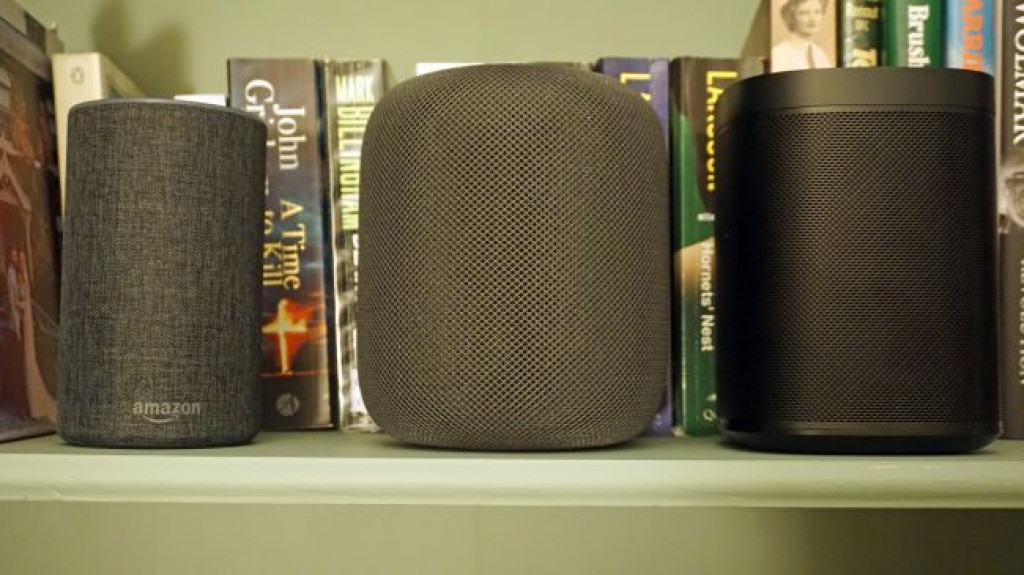
However, the HomePod sounds brilliant and offers some smart Siri functionality… as long as you’re deeply embedded in the Apple ecosystem.
The question we kept asking ourselves, then, is: would we rather have one HomePod, with superior sounds, two Sonos One speakers with good sound plus Alexa / Spotify (and Google Assistant at some point too), or five Amazon Echo devices, offering poorer audio quality but a fully integrated smart home experience?
It’s a tough one, and it depends on how much you want a speaker that seamlessly fits into your Apple life. If you’ve got a MacBook, iPhone, Apple Watch, iPad and Apple TV (and still have any money left at the end of that spending spree), then you’ll find the HomePod is a nice addition to your life.
But there are still a few little bumps in there that remove some of the gloss – Siri not being able to search the web, a lack of Bluetooth streaming, or being able to control your Apple TV or iPhone directly from the speaker are omissions that many would like to have.
In effect, the HomePod feels very beta. We want Siri to be far more capable (a HomePod App Store would be a really useful addition) and for HomeKit to be a bit more robust – we’d also hoped for more on the stereo capabilities too. We’d far more suggest that if you’re buying more than one, you put them in different rooms in the house.
If you only want a great-sounding smart speaker and aren’t fussed about the exclusive aspects of Siri’s functionality then you’ll enjoy the HomePod a lot.
But if you’re a little thriftier, and aren’t exclusively wedded to Apple products, then it’s worth holding off and seeing how the smart speaker market shakes out before making a purchasing decision.
Source: techradar.com









































